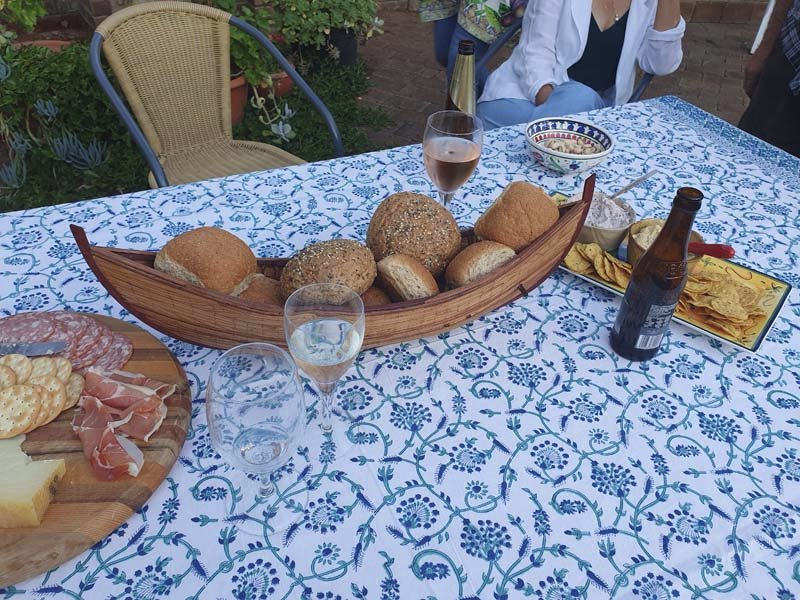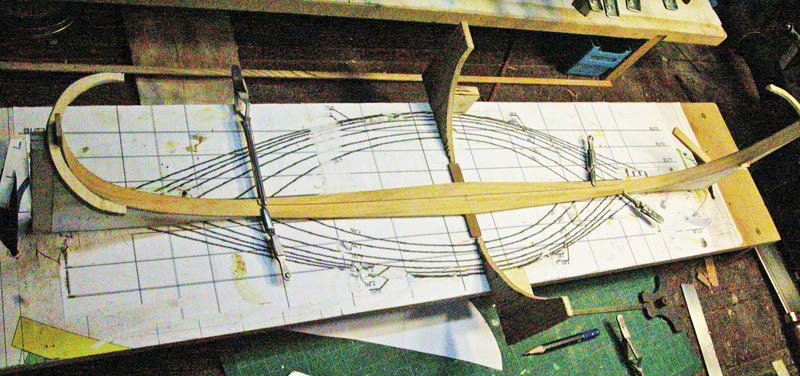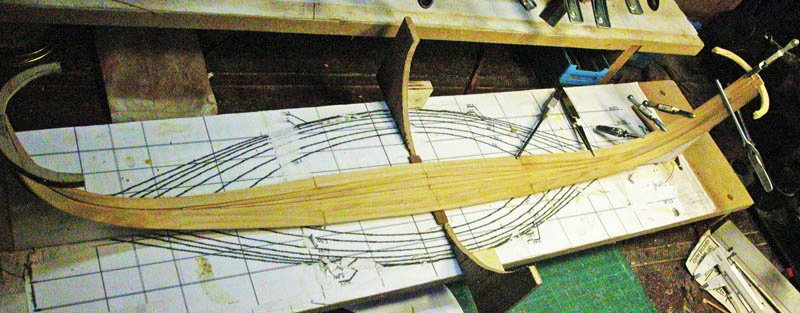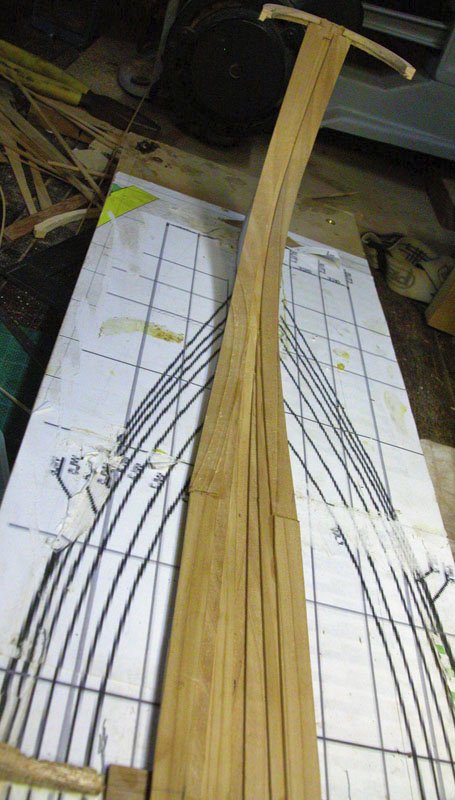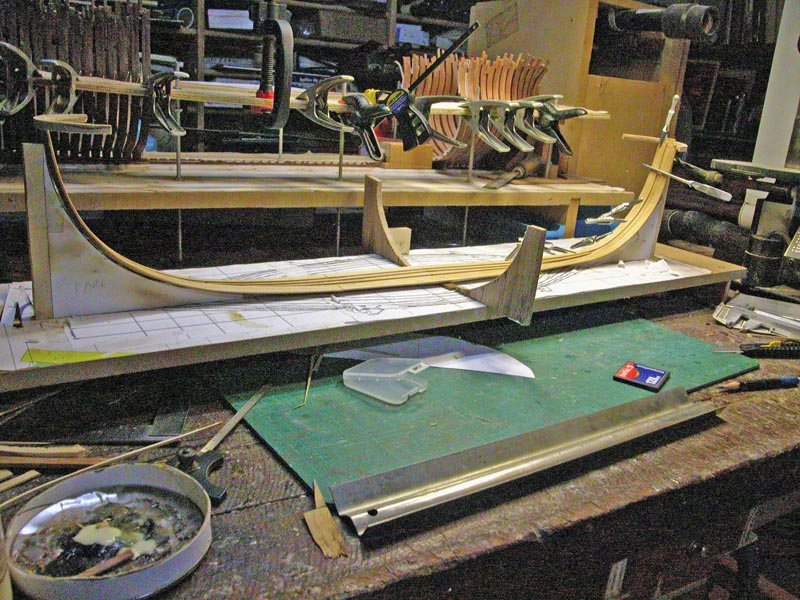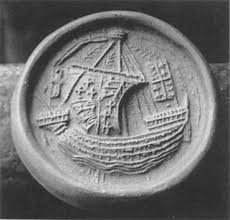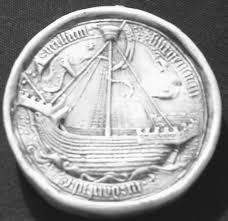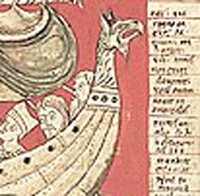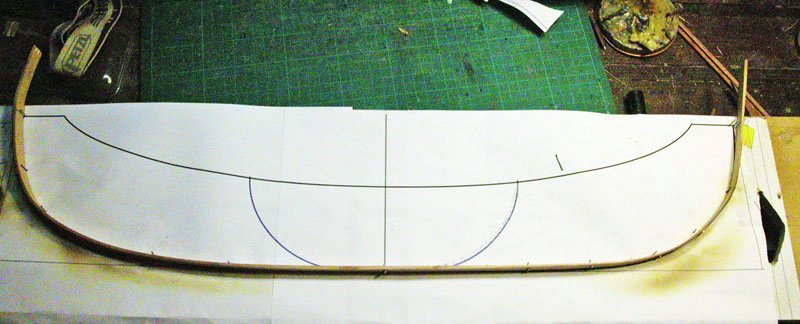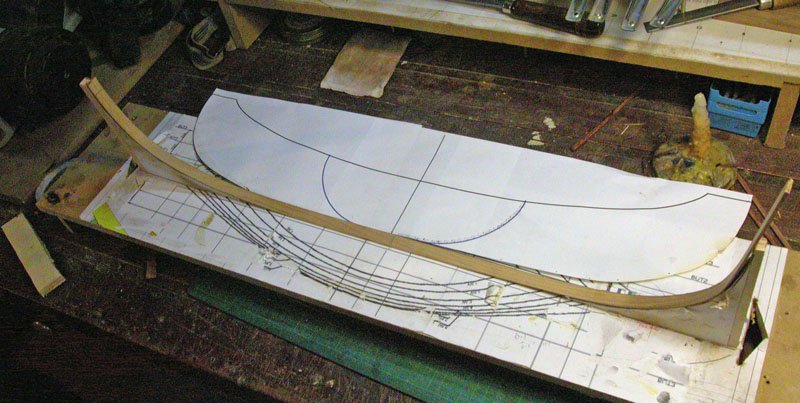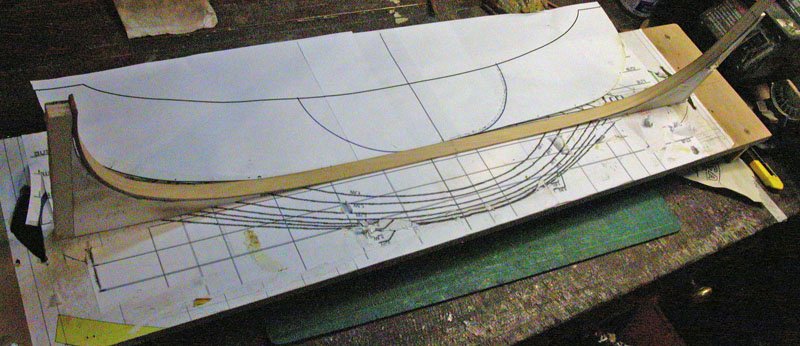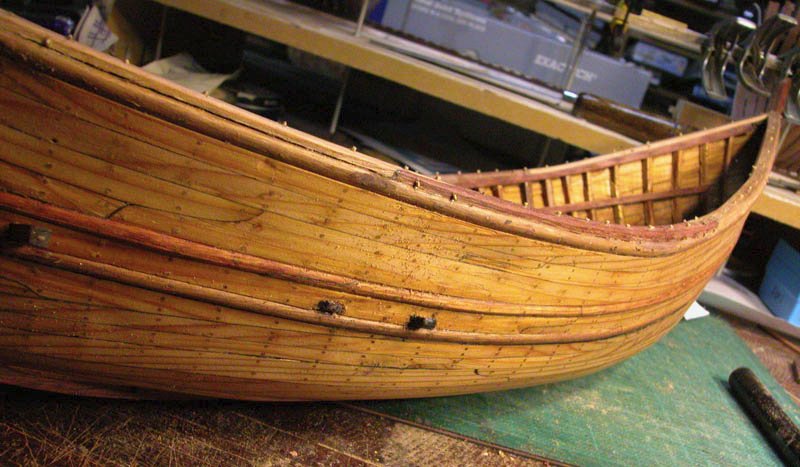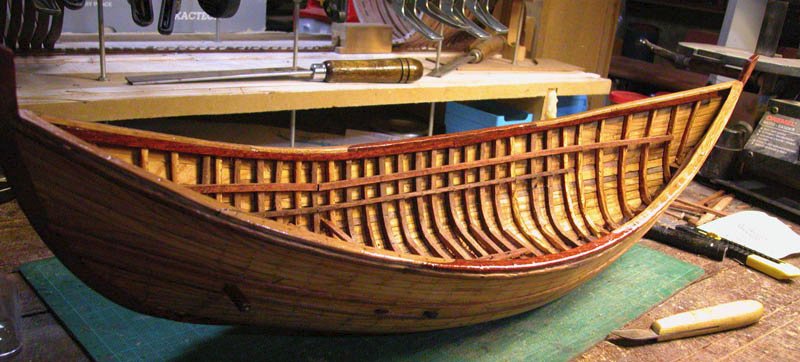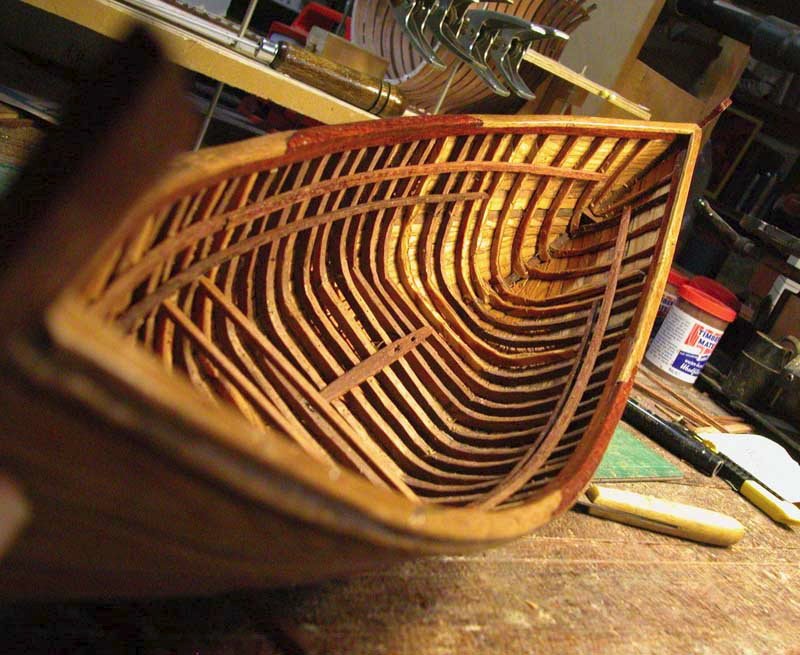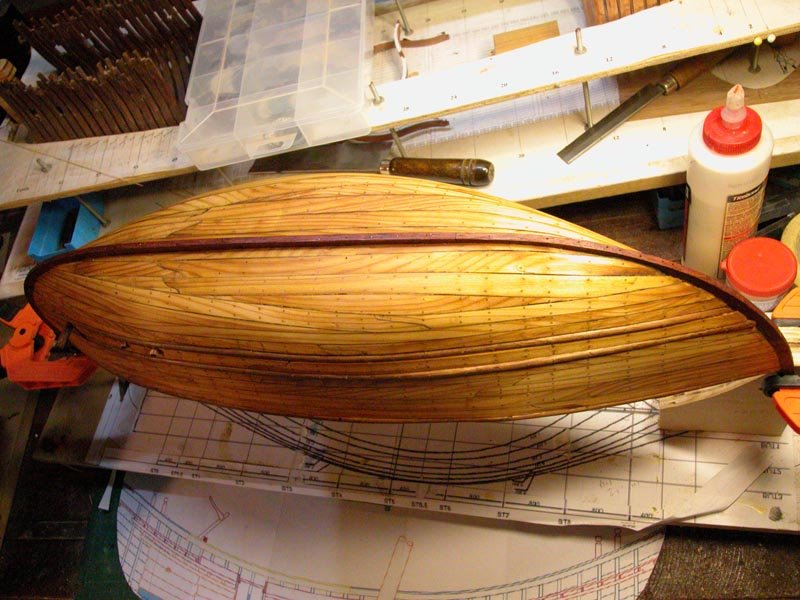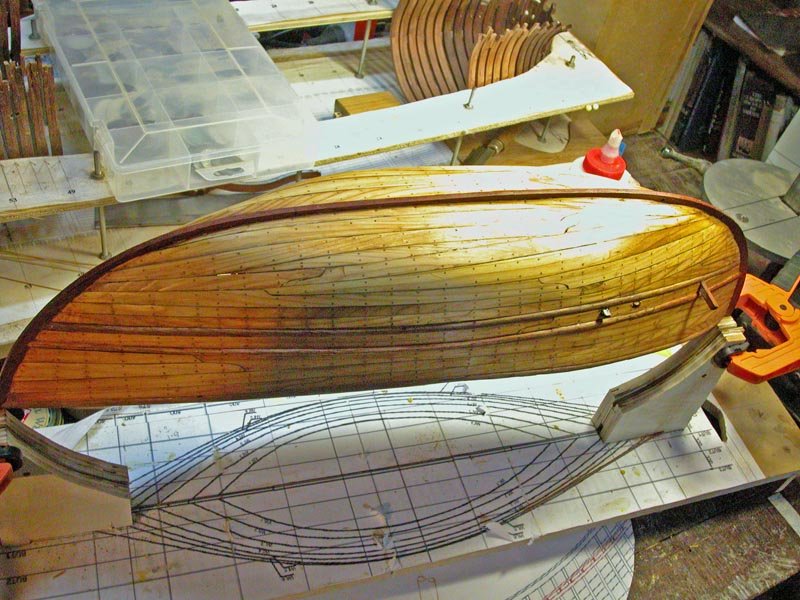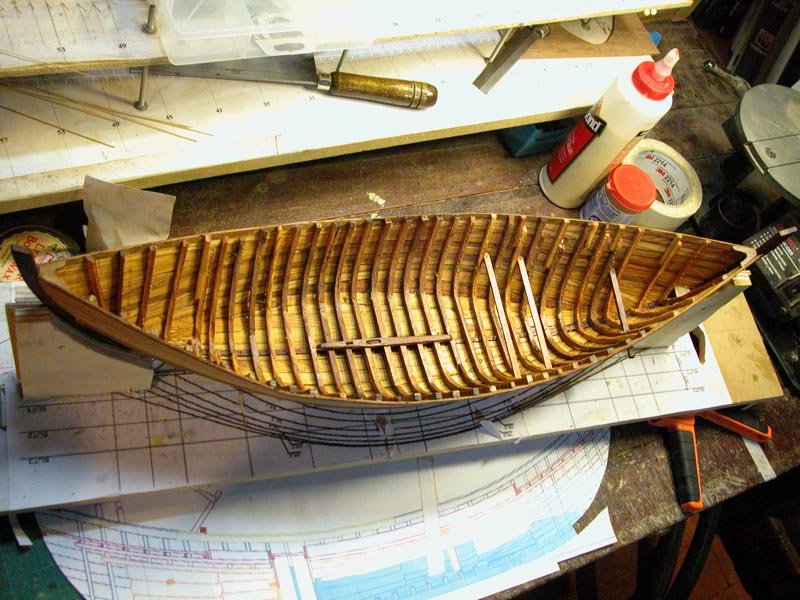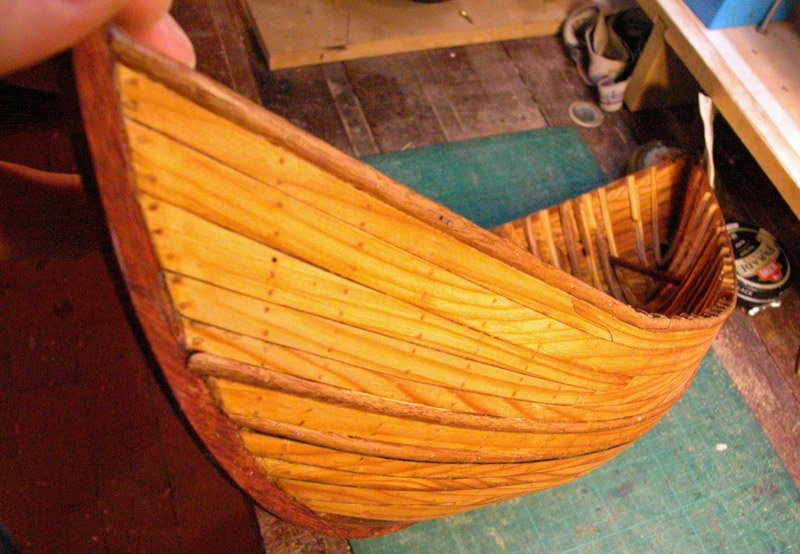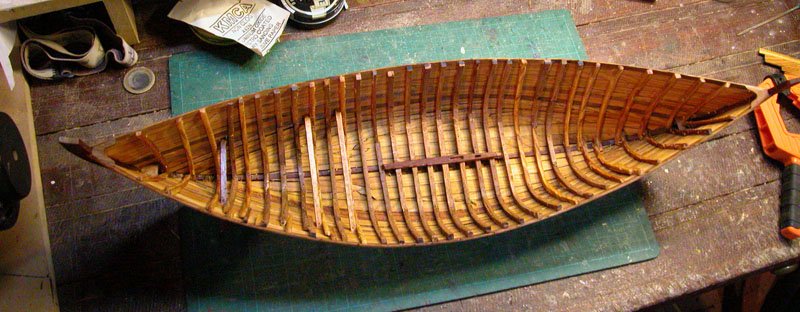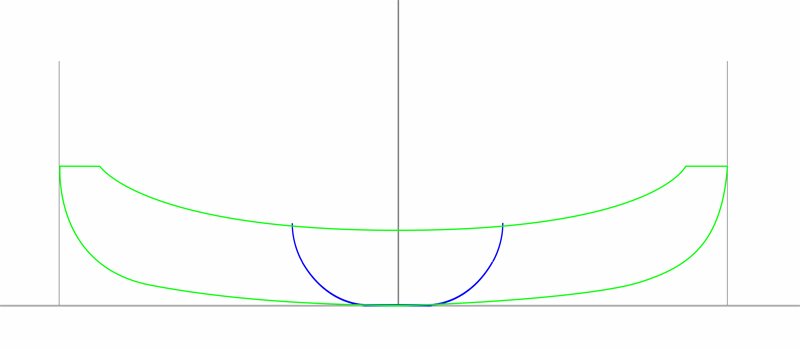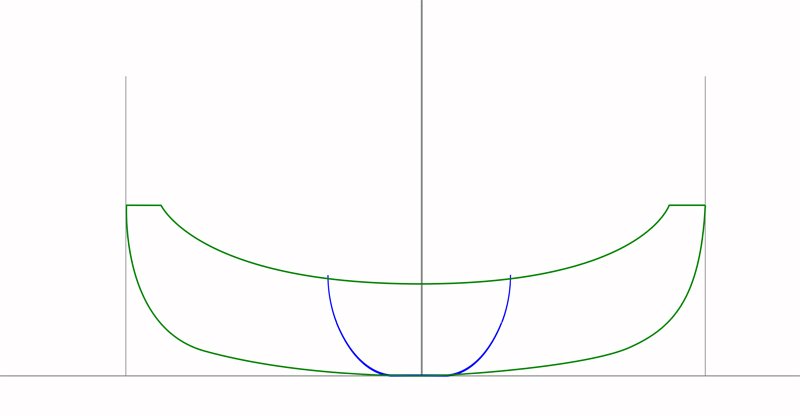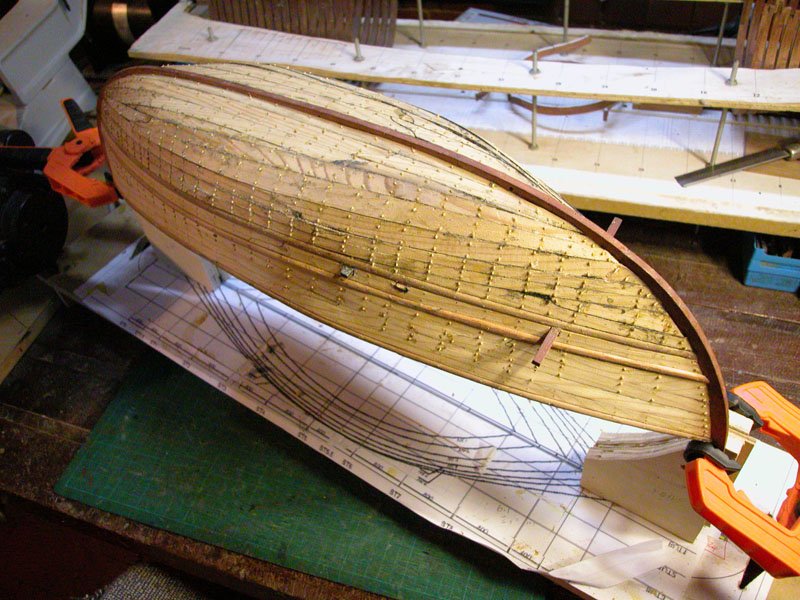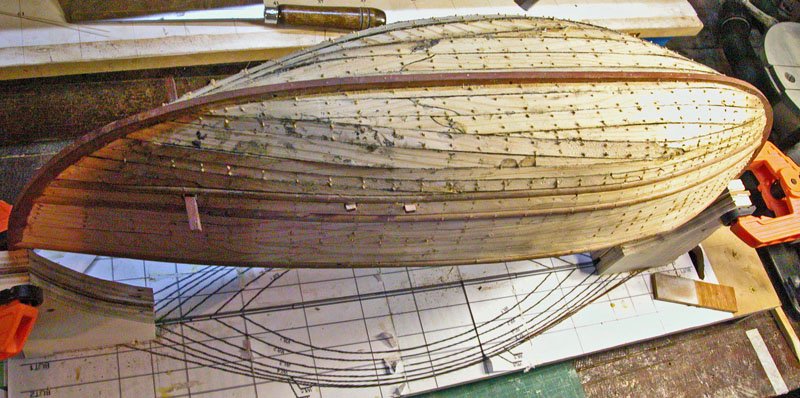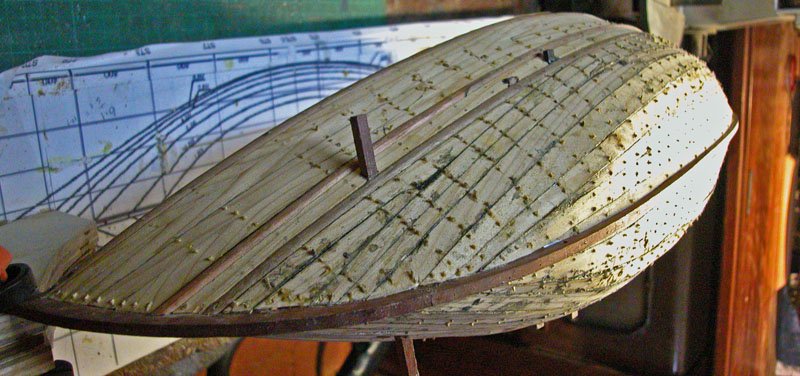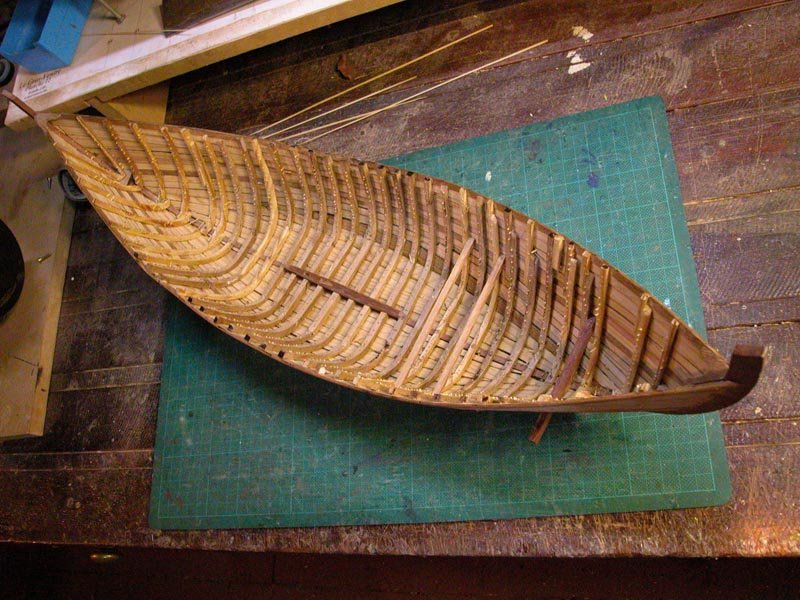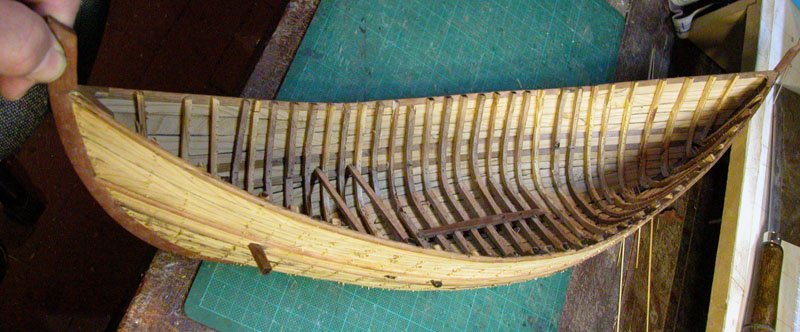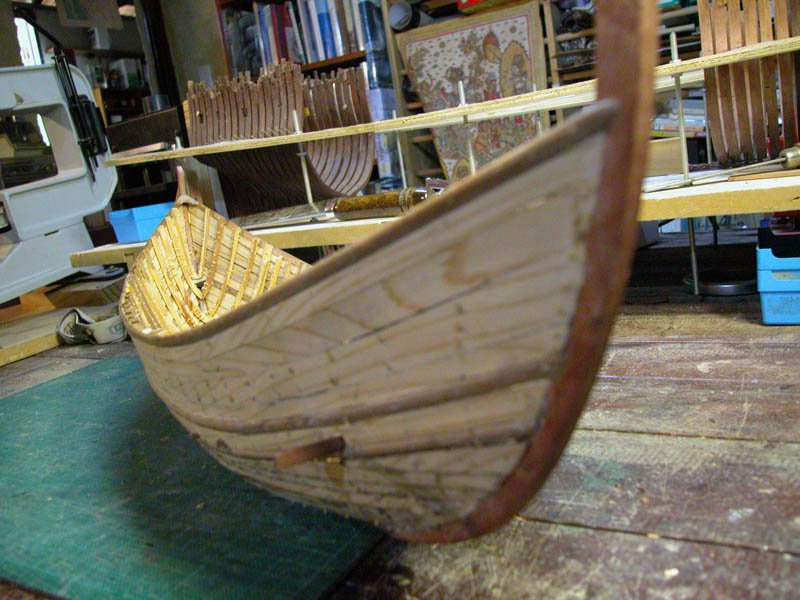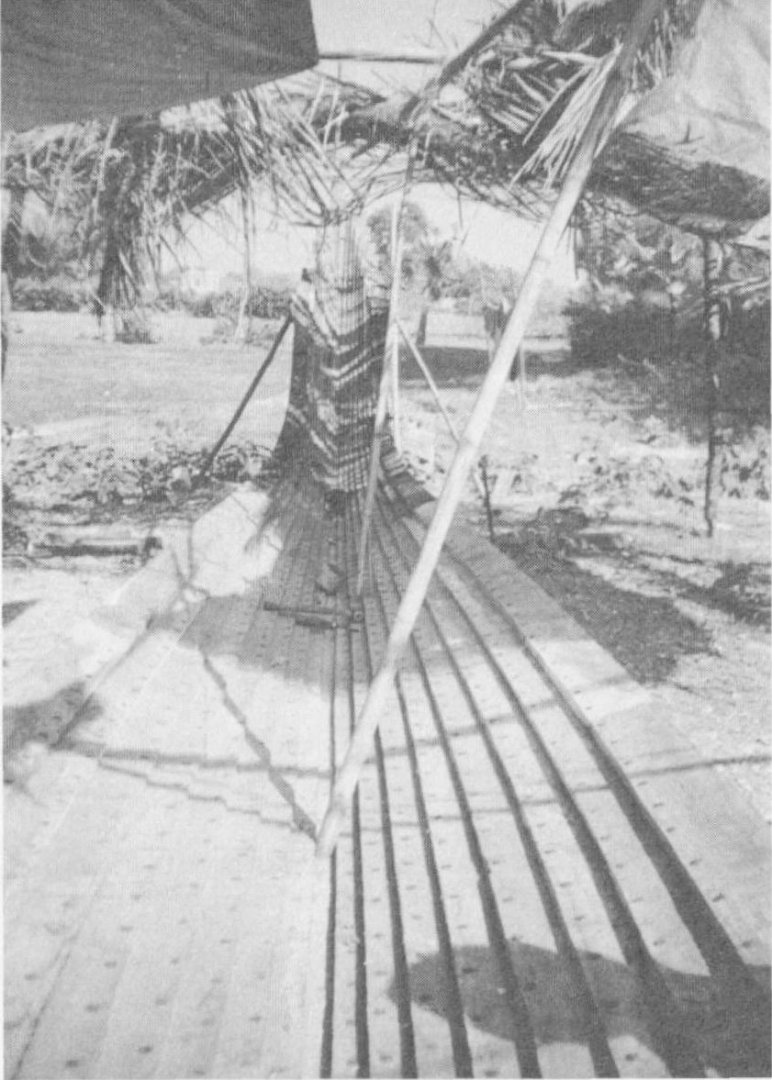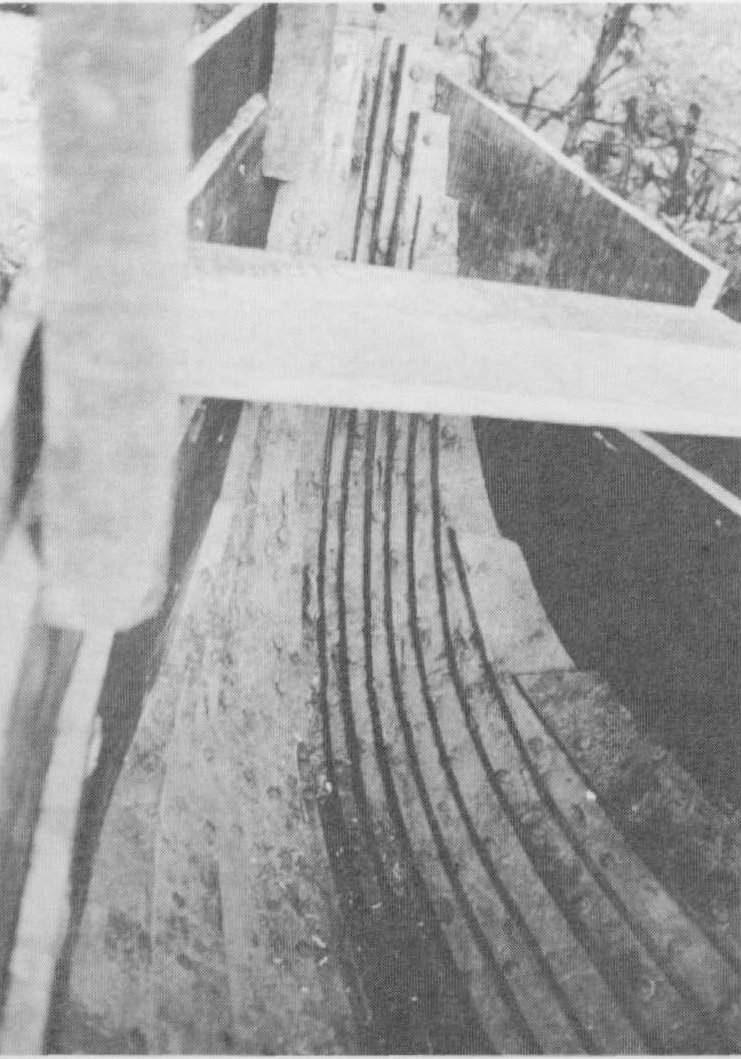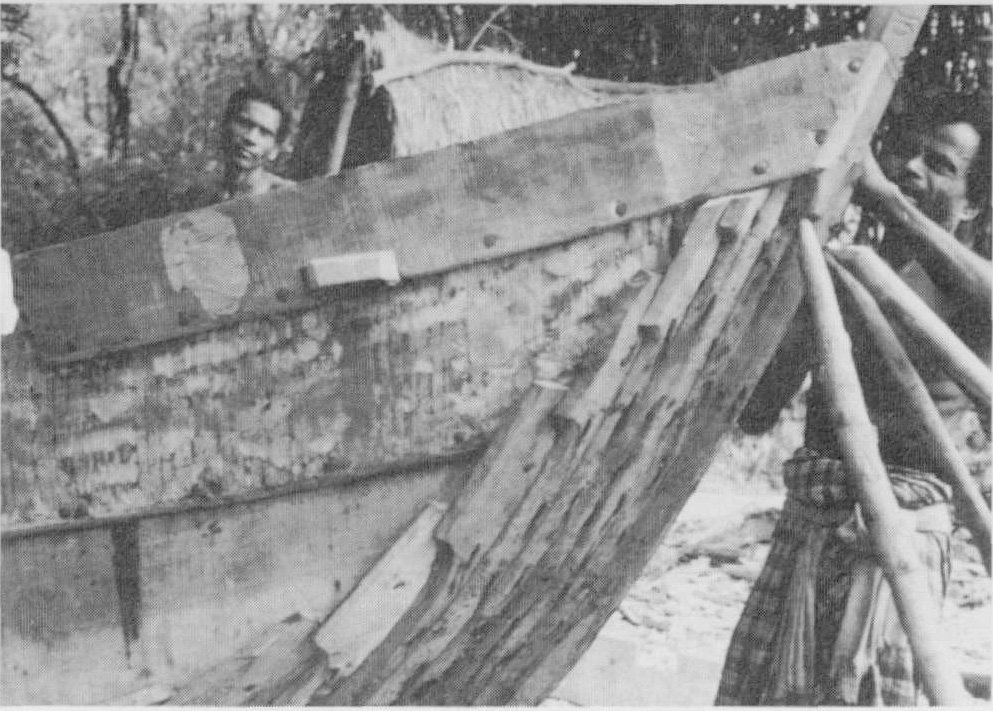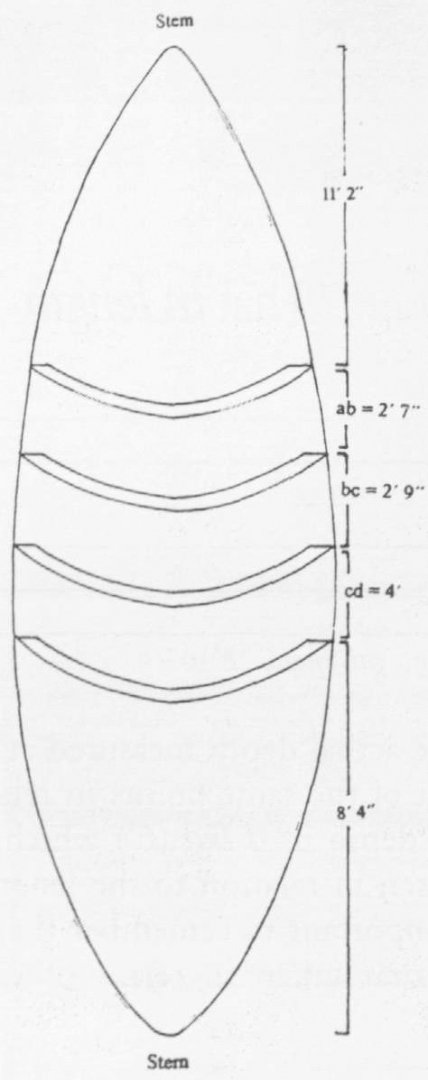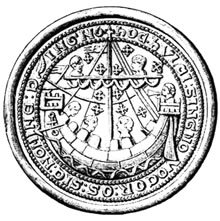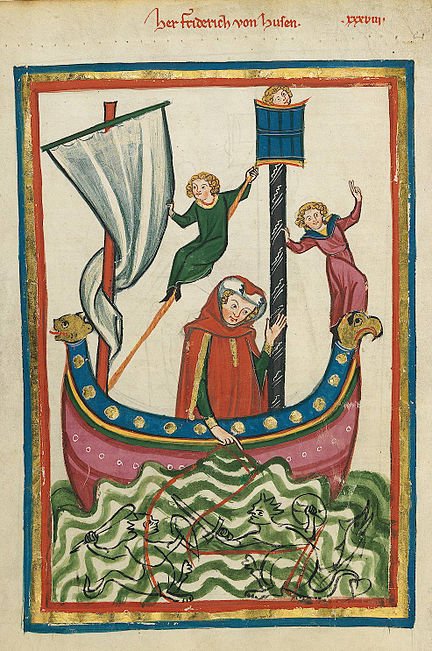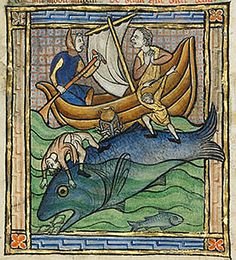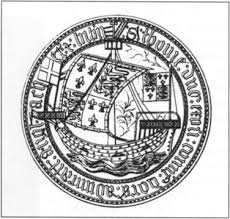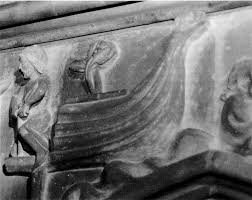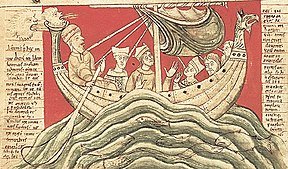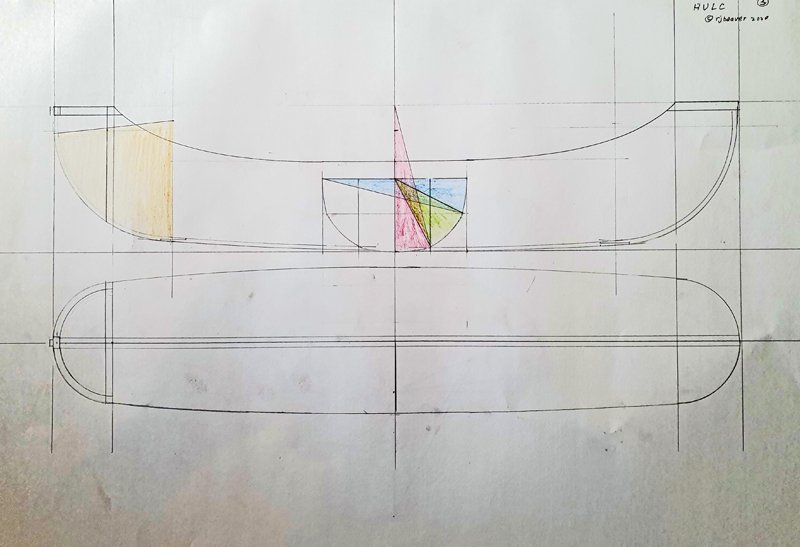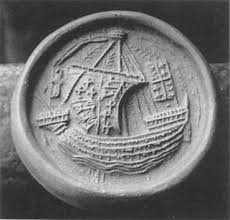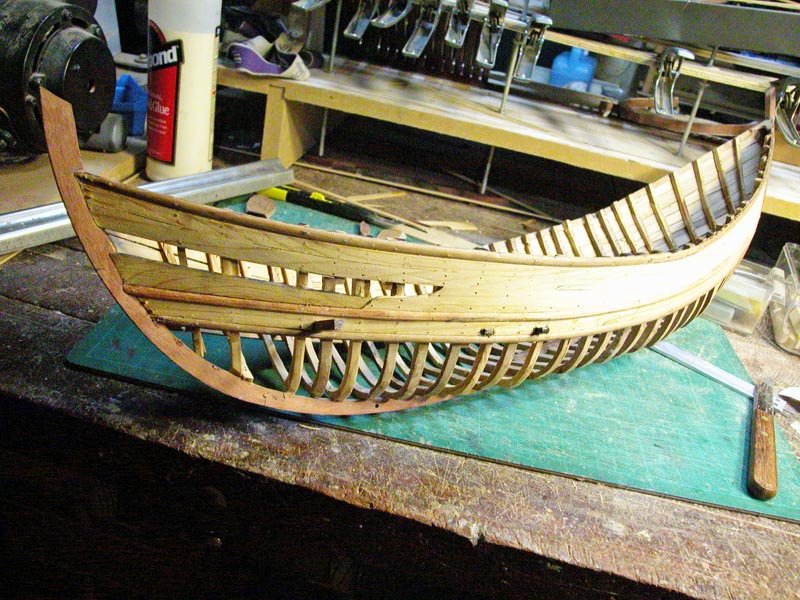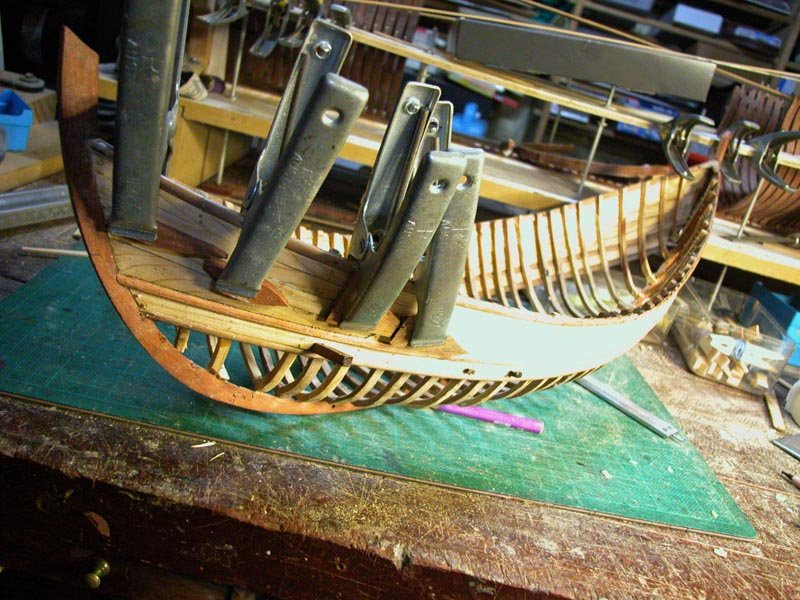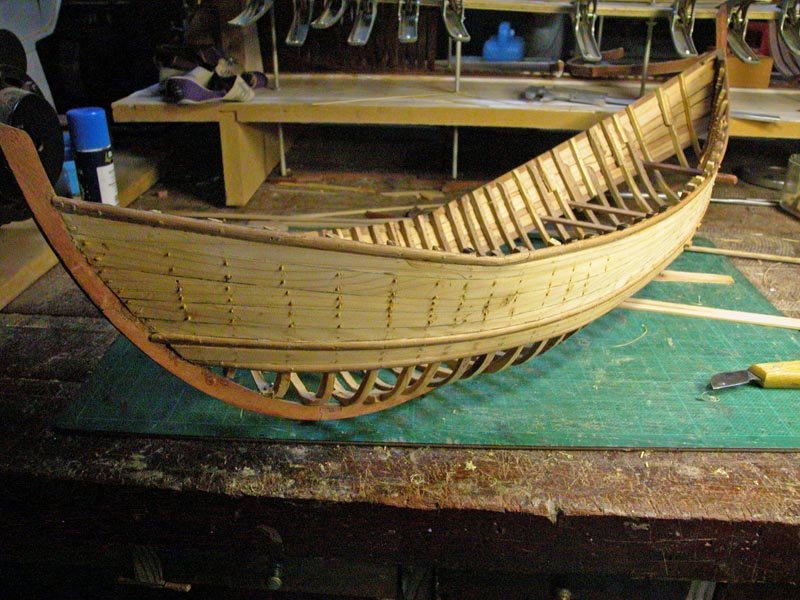-
Posts
832 -
Joined
-
Last visited
Content Type
Profiles
Forums
Gallery
Events
Everything posted by woodrat
-
Our hearts bleed with empathy oozing from our every pore at the thoughts of our southern brothers and sisters in thrall to Covid. The least we can do is have some more dip and another sip of wine. 😢 The Port Admiral did not want to release the bread-boat back to the boatbuilders, however, and tried to claim it as a gift. After a brief mutiny, It has returned to the shed for decking and rigging. Dick
-
What can I say, Steven, that hasn't been said. This is chocolate for the eyes!! The stand really sets it off. What's next? Dick Oh, and please, put it in a display case before the cat jumps on it
-
Here is the start of planking. The garbord strakes and the next two strakes. Note the rabbeted breasthook at stem and stern into which to bolt the strakes. This I think is the "collar" seen on a lot of pictures of hulcs. Cheers Dick
- 186 replies
-
- keelless
- reverse clinker
- (and 4 more)
-
Just to show I haven't repented the errors of my ways, here is the "keel plank" being heat bent to shape and stuck to supporting molds . Cheerio Dick
- 186 replies
-
- keelless
- reverse clinker
- (and 4 more)
-
Unfortunately, once the ceiling planks, decks and half-decks are installed, very little of the frames will be visible. Can't be helped. I am debating whether to fill the hold with amphorae which were found in situ at the excavation. Cheers Dick
-
Thanks, Banyan, I think I will just let the wood seak for itself. I have an aversion to stains and paint except under special circumstances. Here is the hull with gunwales fitted and pinned with dowels. The centre plank is jarrah and different to the other planks on the gunwale. I ran out of wood. But it does show up the sigmoid horizontal scarf. Cheers Dick
-
An excellent project Bolin. I look forward to further reports. Dick
- 179 replies
-
- longship
- Helga Holm
-
(and 1 more)
Tagged with:
-
Thanks, John and Steven. Post sanding and oiling. These vessels were coated in bitumen but I thought that would not display well. Cheers Dick
-
- 186 replies
-
- keelless
- reverse clinker
- (and 4 more)
-
The planking is now complete. After sanding I will work on the internal stringers, internal bulkheads and bitts. The gunwales come last. Cheers Dick
-
"Would you tell me, please, which way I ought to go from here?" "That depends a good deal on where you want to get to," said the Cat. I don't much care where--" said Alice. "Then it doesn't matter which way you go," said the Cat. But there ARE toothed sea-monsters. That's why I don't surf. And there are enough mediaeval illustrations, apart from coins and seals, that show, in some detail, reverse clinker to justify such a representation. I will show the pictures in a later post. These pictures of a patia show reverse clinker being used to produce a large upsweep to the bow. The workmanship is superb. A patia is worth a model in its own right. Dick
- 186 replies
-
- keelless
- reverse clinker
- (and 4 more)
-
Yes, indeed, Andrew. With the Abominable Snowman at the tiller, a Sasquatch as the forrard hand and a unicorn in the hold. And yes, it should be an hulc. Am I planning to put castles on it? It would look like a nude banana without them Dick
- 186 replies
-
- keelless
- reverse clinker
- (and 4 more)
-
As Craig has shown, There is no river Hulk for it to have a mouth. Mouth comes from the anglo-saxon mūða which does mean mouth as in outlet of cf. Portesmūða meaning mouth of the portus. Hence my contention that os hulci means outlet or port for hulks. I think that whichever bored monk was given the job of coming up with a logo for Shoreham had a mean sense of humour which could only be satisfied by punning. The misspelling of singno and dingno is probably due to a dingbat of a carver who couldnt carve letters backwards or had too much mead for breakfast. I'm going away to lie down for a while.😕 Dick
- 186 replies
-
- keelless
- reverse clinker
- (and 4 more)
-
I thought it would come to this, which is why I avoided the etymology of hulc. All the googlies are wrong . dingno is a misspelling for digno. Louis the latin fly's translation was a noble attempt. People have ascribed the name hulk to the greek holcas (probably a towed barge) but this is not likely. It is probably originally from the low countries. Hulkesmouth was the old name of Shoreham till 1541. My translation follows thus: hoc (by this) signo (seal) os (this word which is usually translated as mouth also was used in latin as equivalent to portus or port. Therefore the play on names: port of the hulk = Hulkesmouth), hulci (of the Hulc) vocor (I am called) sic (thus) nomine (by a name) digno (suitable or fitting). Or loosely, "by this seal Hulkesmouth is given a fitting name". This is my translation. Steven's was close. It's all Laughing and Grief to me! Dick
- 186 replies
-
- keelless
- reverse clinker
- (and 4 more)
-
My first draft was twice as wide as the second. As a plan of action I will not be probing blindly with a flashlight. I will use as a sort of template the patia boats of the Bay of Bengal. These vessels had reverse clinker up to the turn of bilge and clinker to the gunwale. They were successful fishing boats and, as I will detail in a later post, have distinct theoretical advantages over clinker. this is a rough plan view of a patia. But I really have no idea of the beam to keel ratio of a hulc. All suggestions will be considered. Dick
- 186 replies
-
- keelless
- reverse clinker
- (and 4 more)
-
Quite so, Craig. Which is when it gets very confusing. Some would say that hulc is a generic term for a heavy seagoing vessel of any type including nefs. Let us say that for the purposes of this conjectural and very suspect model, a hulc has no keel (but may have a false keel), is reverse clinker planked (although it may be normal clinker), is banana shaped and has no stem or stern posts. The Winchelsea thingie is expunged from the list. Clear as mud in a beerbottle! Prof. Jonathan Adams has written on this subject somewhat sceptically (I cant imagine why!): Something is wrong, for if vessels of this type existed in any numbers, especially over a period of many centuries, then there must have been losses, abandonments and re-use. It would be odd then, even given the vagaries of the archaeological record and all the other factors that influence patterns of discovery, if none had been found. .................. But as we know that ships called hulks certainly did exist, including their equivalents elsewhere such as the Portuguese urca, in view of the number of medieval ships and boats that have been found, the implication is that among their number we may have been looking at hulks all the time. Adams, J. R.. A Maritime Archaeology of Ships: Innovation and Social Change in Late Medieval and Early Modern Europe . Oxbow Books. So the implication is that the hulc as a distinct type may not have existed but was a whole horde of different hull types lumped together (even nefs) and that the funny looking banana boats are an artefact produced by deluded illuminators and by sculptors forced to fit pictures of ships on round coins and seals. That would be sad. So I prefer to believe on the basis of no science that it would be nice if hulcs were real and would like a lovely spurious model of one to put on my shelf. By the way, I have a cunning plan which may show how reverse clinker is not as silly as it sounds and indeed has theoretical advantages over normal clinker. The whale pictured under the boat is I think a representation of the voyage of St Brendan not the Bible Yours spuriously Dick
- 186 replies
-
- keelless
- reverse clinker
- (and 4 more)
-
As there is no extant picture of either, I would hesitate to conjecture. However, I hope I will not end up finding a boo..........
- 186 replies
-
- keelless
- reverse clinker
- (and 4 more)
-
Despite the better angels of my nature, I feel constrained to go where the prudent would fear to venture. The nautical archaeologists have despaired of one particular ship type: the "mysterious" hulc (also spelt hulk in english). This is a type of ship depicted on town seals, coins, illuminated manuscripts, baptismal fonts, church pews and probably toilet walls during the late mediaeval period. It seems to have largely supplanted the cog but also predated it. Having plodded through many learned disquisitions on the subject and squinted at dozens of poorly done illustrations of vessels which look strangely like those in the "Owl and the Pussycat", I have decided to dive down the rabbit-hole. The problem is that no-one has found a single wreck which can with a straight face be identified as a hulc. And this is a vessel said to be widespread from the baltic to Portugal and beyond for centuries. Curiouser and curiouser. And what are the supposed characteristics of this apocryphal beastie? It was, on the basis of town seals etc. to be a largeish banana-shaped vessel with often depicted reverse-clinker planking (reverse lapstrake), no keel, no stem or stern post, square sails and a funny looking collar round its neck. If you told a five year old " draw daddy a sailing ship", this is what they would draw. Nonetheless, whole forests have been denuded by learned nauticals writing exhaustive academic blatherings on this unicorn of the oceans. Academic reputations have risen and fallen on the deck of the Incredible Hulc. Here are some typical examples of the elusive animal which seems, like the Cheshire cat, to have faded away leaving only a quizzical grin. Is it possible to do a model of one of these things based on the above? Maybe not but perhaps it would be fun to try. As a first toe in the ocean, I spent last weekend at the drawing board trying to pull all the elements together into something that looked sturdy, workaday and able to withstand storms in the Baltic and Bay of Biscay. It also had to be somewhat banana-like. Here 'tis: I think it looks like your generic mediaeval ship and lacks only castles. I don't think it quite catches the eccentricity of the banana boats and I plan to rethink. "I see nobody on the road" said Alice. "I only wish I had such eyes" the King remarked in a fretful tone. "To be able to see Nobody! And at that distance too!" Cheers Dick
- 186 replies
-
- keelless
- reverse clinker
- (and 4 more)
-
An interesting study by Helfmann et al. [May 2019 Journal of Maritime Archaeology 14(31)] on mediaeval hulls looking at von Mises stress analysis of different hull types found: "The FEA results from this study demonstrated that three critical interdependent factors determined the relative strengths of shell-first and frame-based techniques: the number of transverse frames, the number of longitudinal reinforcements, and their relative locations." In particular they found that shell-first hulls were greatly stiffer than frame-first hulls UNTIL longitudinal stringers were added. The ninth century was a transitional time from shell-first to frame-first and the Yenikapi 12 showed evidence of both techniques. Longitudinal stringers were used. Dick
-
Thanks Vaddoc, Binho and Steven. The consensus from the turkish archaeologists seems to be that it is likely to have been built in the Black Sea region. They also believe that the flat bottom was built first then frames added to the bottom. From this point the build proceeded as for skeleton construction. Dick
-
I was being a little naughty about the hulc, Pat, but, now that I have thought about it , it's not that bad an idea. I might give it a go soon. I have now planked down to the first wale and will start on the flat bottom. Should be easy till I get to the trun of the bilgeawaiting a stealer Cheers Dick
-
Thanks Pat. As you can see from early posts it was not smooth sailing. I look forward to your upcoming build of a northern hulc from the extensive excavations of this well recorded vessel. Best of westralian luck to you Dick
-
Thanks, Pat. I wouldn't dream of it. Steven must be going cross-eyed by now. I may have a go myself, though. I think it would have a crew of 2. Dick
-
I applaud your choice of subject and have something of a penchant for the working mediaeval vessel myself. I am happy to see you are referencing the excavation report. Do not hesitate to contact the archaeologists as they will undoubtedly be keen to assist you. Those trenails seem a little oversized. Does the thesis give information on their diameter. I find Byrnes trenail maker very cheap and easy to use to get accurate diameters of trenails (I use split bamboo to make them). Good luck with your build of a very interesting vessel. Cheers Dick
About us
Modelshipworld - Advancing Ship Modeling through Research
SSL Secured
Your security is important for us so this Website is SSL-Secured
NRG Mailing Address
Nautical Research Guild
237 South Lincoln Street
Westmont IL, 60559-1917
Model Ship World ® and the MSW logo are Registered Trademarks, and belong to the Nautical Research Guild (United States Patent and Trademark Office: No. 6,929,264 & No. 6,929,274, registered Dec. 20, 2022)
Helpful Links
About the NRG
If you enjoy building ship models that are historically accurate as well as beautiful, then The Nautical Research Guild (NRG) is just right for you.
The Guild is a non-profit educational organization whose mission is to “Advance Ship Modeling Through Research”. We provide support to our members in their efforts to raise the quality of their model ships.
The Nautical Research Guild has published our world-renowned quarterly magazine, The Nautical Research Journal, since 1955. The pages of the Journal are full of articles by accomplished ship modelers who show you how they create those exquisite details on their models, and by maritime historians who show you the correct details to build. The Journal is available in both print and digital editions. Go to the NRG web site (www.thenrg.org) to download a complimentary digital copy of the Journal. The NRG also publishes plan sets, books and compilations of back issues of the Journal and the former Ships in Scale and Model Ship Builder magazines.




